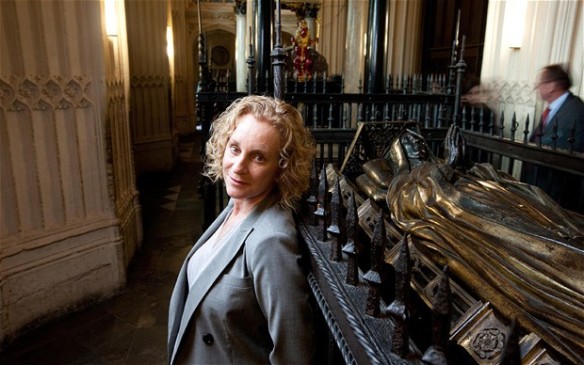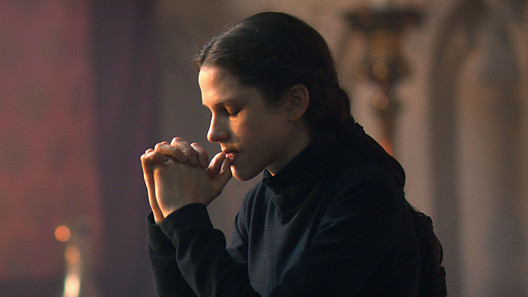During the 15th century the Church banned sex on every Sunday during Lent, and for pretty much half the rest of the year as well. But you seriously have to wonder how much notice anyone took of this papal ruling, especially if you’re watching The White Queen (BBC1 Sunday).
Edward IV and Elizabeth Woodville tear each other’s clothes off every time they see one another and in yesterday’s episode even pious Margaret Beaufort returned to the marital bed, although she only did it for king and country.
The ‘no sex please, we’re British’ had little impact upon the number of births either, with high born women suffering more than their peasant, breast feeding sisters. Aristocratic ladies handed their new borns to a wet nurse and were pretty soon pregnant again.
White Queen, Elizabeth had a total of twelve children by two husbands while her mother, Jacquetta of Luxembourg, Countess Rivers had fourteen, and these were just the babies who survived long enough to make an entry in the history books.
Richard Neville, 16th Earl of Warwick and the infamous Kingmaker, was himself one of ten children, although his own progeny appeared to number just two long suffering daughters.
It was his daughter Isabelle viewers witnessed give birth at sea during a storm conjured up by witchcraft and Elizabeth Woodville, her mother and Elizabeth’s sweet faced daughter. Isabelle, the wife of Edward’s traitorous brother George went on to have at least two children that survived to adulthood. Her daughter was Margaret, Countess of Salisbury.
But let’s return to roguish Richard Neville and his sisters who surely deserve a series of their own, or at the very least, a novel by Philippa Gregory.

Philippa Gregory standing next to Margaret Beaufort’s tomb in Westminister Abbey http://www.telegraph.co.uk
Marriage was the only career option for the medieval woman, and even then they had very little say in the matter. Advantageous dynastic pairings were everything, which indirectly led to the whole Cousins’ War disaster.
Divorce was unheard of and the only way to escape an unhappy marriage was to discover you were related to your husband or prove you had previously been contracted to another. If you had been married under age that counted as well, although with betrothals made in childhood this might be a tricky one to argue. One get out clause was an impotent husband, but merely being violent didn’t count. Husbands were allowed to beat their wives with sticks or whips because apparently it was good for them. However, if you could prove your husband intended to kill you, then that was a valid reason for an annulment.
All that being said, Richard’s elder sister Joan seems to have fared pretty well in the marital stakes. Joan was born in 1424, the first of Richard Neville, Earl of Salisbury’s large brood by his wife Alice Montacute. Fifteenth century babies were usually named for their Godparents who played a prominent role in the child’s life. Joan, however, appears to have been named for her paternal grandmother, Joan Beaufort.
Joan spent her early childhood at Middleham Castle, the Salisbury family seat In Wensleydale, Yorkshire. She may have been removed to a neighbouring nobleman’s household to learn the art of estate management, as was the medieval custom.
Her expensive marriage contract to William Fitzalan, Earl of Arundel, was bought from the Crown by her ambitious father, and she was married at around the age of 14. Her groom was nearer 21 years old, but it is not know if the couple set up home together immediately following the ceremony, especially as their eldest son was not born until 1450. Joan’s marital home was Arundel Castle in Sussex, owned by the Fitzalan family from 13th to 16th century. Joan had at least five children. Thomas, Lord Maltravers, the Arundel heir married Margaret Woodville, Elizabeth’s sister.
Joan died in 1462, shortly before her sister Katherine’s marriage to Lord Hastings. She was buried in the Fitzalan Chapel adjoining St Nicholas’s Church near Arundel Castle, where her husband eventually joined her.
William survived his wife by 25 years, during which he showed no inclination to remarry. He withdrew from national politics and tried to keep his distance from war mongering brother in law, Richard Neville.

Joan Neville, Countess of Arundel – see also TudorQueen6
The magnificent memorial to Joan and William enjoyed a makeover in 1982 when it was re sited on a slate slab in front of the altar. Husband and wife rest their feet on the Fitzalan horse and a griffin, their heads supported by angels. Joan wears a York collar depicting suns and roses and the effigies still bear traces of original colouring and gilding.




Do you know if there is any link to Anne Neville (alternatively listed as de Neville), who was the 2nd wife of Sir John St. John? There’s an American lineage of the St. Johns, out of Cressit St. John who married John Boteler (Butler line in America). Their son John’s family moved to Virginia sometime in the 1600s. Cressit (also spelled Cressid, Cressyd, Cressitt) appears to be from the union of St. John and Anne Neville … but she could alternatively be the daughter of first wife Margaret?
It would be great to know if there anything to be learned about Lady Cressit St. John….and the marriage, immigration of their children. Another “pioneer” family….
Hi Bridget,
Cressit St John is not a name I have come across, but I will definitely look into this lady’s lineage and see what I can discover. Thank you for taking the time to comment.
Only just noticed this comment from Bridget. Cressit St.John was the daughter of John St.John of Bletsoe (d. 19 Dec. 1558) who had five children by his mistress Anne Nevell (d. 1595). The relationship and the children are recorded in the Visitations of Bedfordshire 1566 page 53. So far, all my research into the St.John Genealogy has shown that all children have been acknowledged by their father. Good Gentlewoman knows how to contact me if more information is wanted.